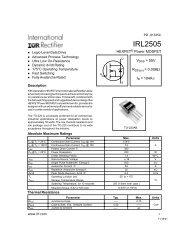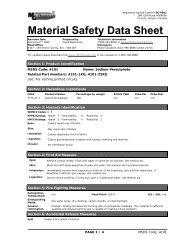SWITCHMODE⢠Power Supply Reference Manual
SWITCHMODE⢠Power Supply Reference Manual
SWITCHMODE⢠Power Supply Reference Manual
You also want an ePaper? Increase the reach of your titles
YUMPU automatically turns print PDFs into web optimized ePapers that Google loves.
SMPSRMThe forward conduction loss of a rectifier is shown inFigure 25. During turn–off, the rectifier exhibits a reverserecovery loss where minority carriers trapped within theP–N junction must reverse their direction and exit thejunction after a reverse voltage is applied. This results inwhat appears to be a current flowing in reverse throughthe diode with a high reverse terminal voltage.The switching loss is the instantaneous product of theterminal voltage and current of a power device when it istransitioning between operating states (on–to–off andoff–to–on). Here, voltages are transitional betweenfull–on and cutoff states while simultaneously the currentis transitional between full–on and cut–off states. Thiscreates a very large V–I product which is as significant asthe conduction losses. Switching losses are also the majorfrequency dependent loss within every PWM switchingpower supply.The loss–induced heat generation causes stress withinthe power component. This can be minimized by aneffective thermal design. For bipolar power transistors,however, excessive switching losses can also provide alethal stress to the transistor in the form of secondbreakdown and current crowding failures. Care should betaken in the careful analysis of each transistor’s ForwardBiased–Safe Operating Area (FBSOA) and ReverseBiased–Safe Operating Area (RBSOA) operation.DIODE VOLTAGE(VOLTS)FORWARD VOLTAGEREVERSE VOLTAGEDIODE CURRENT(AMPS)FORWARDRECOVERYTIME (T fr )FORWARD CONDUCTION CURRENTDEGREE OF DIODERECOVERYABRUPTNESSI PKREVERSERECOVERYTIME (T rr )INSTANTANEOUS ENERGYLOSS (JOULES)FORWARD CONDUCTION LOSSSWITCHINGLOSSFigure 25. Stresses and Losses within RectifiersTechniques to Improve Efficiency inSwitching <strong>Power</strong> SuppliesThe reduction of losses is important to the efficientoperation of a switching power supply, and a great dealof time is spent during the design phase to minimize theselosses. Some common techniques are described below.The Synchronous RectifierAs output voltages decrease, the losses due to theoutput rectifier become increasingly significant. ForV out = 3.3 V, a typical Schottky diode forward voltage of0.4 V leads to a 12% loss of efficiency. Synchronousrectification is a technique to reduce this conduction lossby using a switch in place of the diode. The synchronousrectifier switch is open when the power switch is closed,and closed when the power switch is open, and istypically a MOSFET inserted in place of the outputrectifier. To prevent ”crowbar” current that would flow ifboth switches were closed at the same time, the switchingscheme must be break–before–make. Because of this, adiode is still required to conduct the initial current duringthe interval between the opening of the main switch andthe closing of the synchronous rectifier switch. ASchottky rectifier with a current rating of 30 percent ofhttp://onsemi.com25













